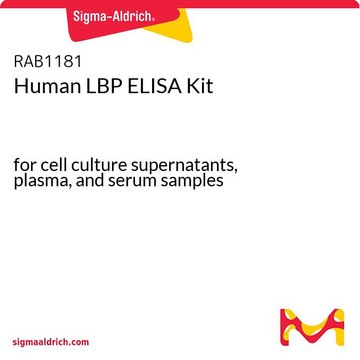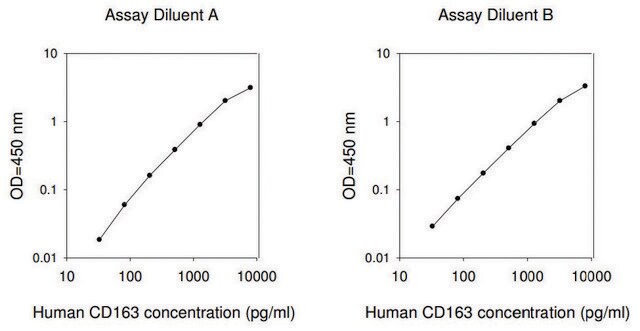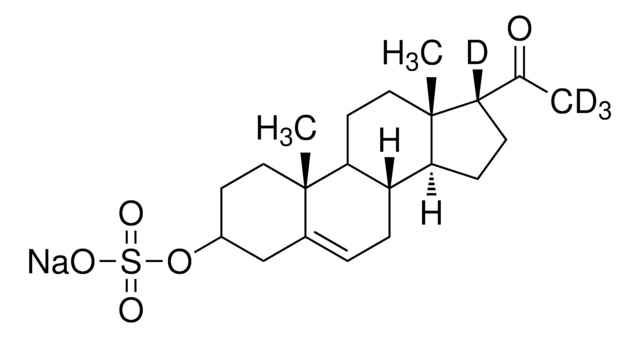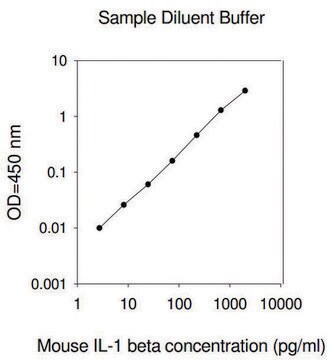RAB0081
Human CD14 ELISA Kit
for serum, plasma, cell culture supernatant and urine
Iniciar sesiónpara Ver la Fijación de precios por contrato y de la organización
About This Item
UNSPSC Code:
41116158
NACRES:
NA.32
Productos recomendados
species reactivity
human
packaging
kit of 96 wells (12 strips x 8 wells)
technique(s)
ELISA: suitable
capture ELISA: suitable
input
sample type cell culture supernatant(s)
sample type urine
sample type plasma
sample type serum
assay range
inter-assay cv: <12%
intra-assay cv: <10%
sensitivity: 6 pg/mL
standard curve range: 8.23-6000 pg/mL
detection method
colorimetric
shipped in
wet ice
storage temp.
−20°C
Gene Information
human ... CD14(929)
General description
The Human CD14 ELISA (Enzyme-Linked Immunosorbent Assay) kit is an in vitro enzyme-linked immunosorbent assay for the quantitative measurement of human CD14 in serum, plasma, cell culture supernatants and urine.
Immunogen
Recombinant Human CD14
Application
For research use only. Not for use in diagnostic procedures.
Please refer to the attached General ELISA KIT Procedure (sandwich, competitive & Indirect ELISA)
Please refer to the attached General ELISA KIT Procedure (sandwich, competitive & Indirect ELISA)
Biochem/physiol Actions
Cluster of differentiation 14 (CD14) is present on the dendritic cells (DCs), macrophages, and monocytes. It is a glycoprotein that lacks a transmembrane domain and is attached to the cell surface by a glycosylphosphatidylinositol (GPI) anchor. CD14 plays a crucial role in the recognition of bacteria and in immune reactivation. It also plays a key role in host responses related to the recognition of viral components by the lungs. The Human CD14 enzyme-linked immunosorbent assay (ELISA) kit is an in vitro enzyme-linked immunosorbent assay for the quantitative measurement of human CD14 in serum, plasma, cell culture supernatants, and urine.
Other Notes
A sample Certificate of Analysis is available for this product.
Please type the word sample in the text box provided for lot number.
Please type the word sample in the text box provided for lot number.
signalword
Warning
hcodes
pcodes
Hazard Classifications
Met. Corr. 1
Storage Class
8A - Combustible corrosive hazardous materials
Elija entre una de las versiones más recientes:
¿Ya tiene este producto?
Encuentre la documentación para los productos que ha comprado recientemente en la Biblioteca de documentos.
Thomas Damgaard Sandahl et al.
The American journal of gastroenterology, 109(11), 1749-1756 (2014-08-27)
Inflammatory activation of resident hepatic macrophages (Kupffer cells) by portal-derived lipopolysaccharide (LPS) has a primary role in animal models of alcoholic liver disease, but it has not been systematically or longitudinally studied in human alcoholic hepatitis (AH). We followed 50
Fatemeh Zamani et al.
Advanced pharmaceutical bulletin, 3(2), 329-332 (2013-12-07)
CD14, one of the main differentiation markers on the surface of myeloid lineage cells, acts as a key role in activation of LPS-induced monocytes. LPS (lipopolysaccharide) binds to LPS-binding protein in plasma and are delivered to the cell surface receptor
Megan Crane et al.
The Journal of infectious diseases, 210(5), 745-751 (2014-03-04)
We investigated the relationship between microbial translocation, immune activation, and liver disease in human immunodeficiency virus (HIV)/hepatitis B virus (HBV) coinfection. Lipopolysaccharide (LPS), soluble CD14, CXCL10, and CCL-2 levels were elevated in patients with HIV/HBV coinfection. Levels of LPS, soluble
Laure Campillo-Gimenez et al.
The Journal of allergy and clinical immunology, 134(5), 1142-1152 (2014-07-22)
Despite control of HIV infection under antiretroviral therapy (ART), immune T-cell activation persists in patients with controlled HIV infection, who are at higher risk of inflammatory diseases than the general population. PMNs play a key role in host defenses against
Nuestro equipo de científicos tiene experiencia en todas las áreas de investigación: Ciencias de la vida, Ciencia de los materiales, Síntesis química, Cromatografía, Analítica y muchas otras.
Póngase en contacto con el Servicio técnico







